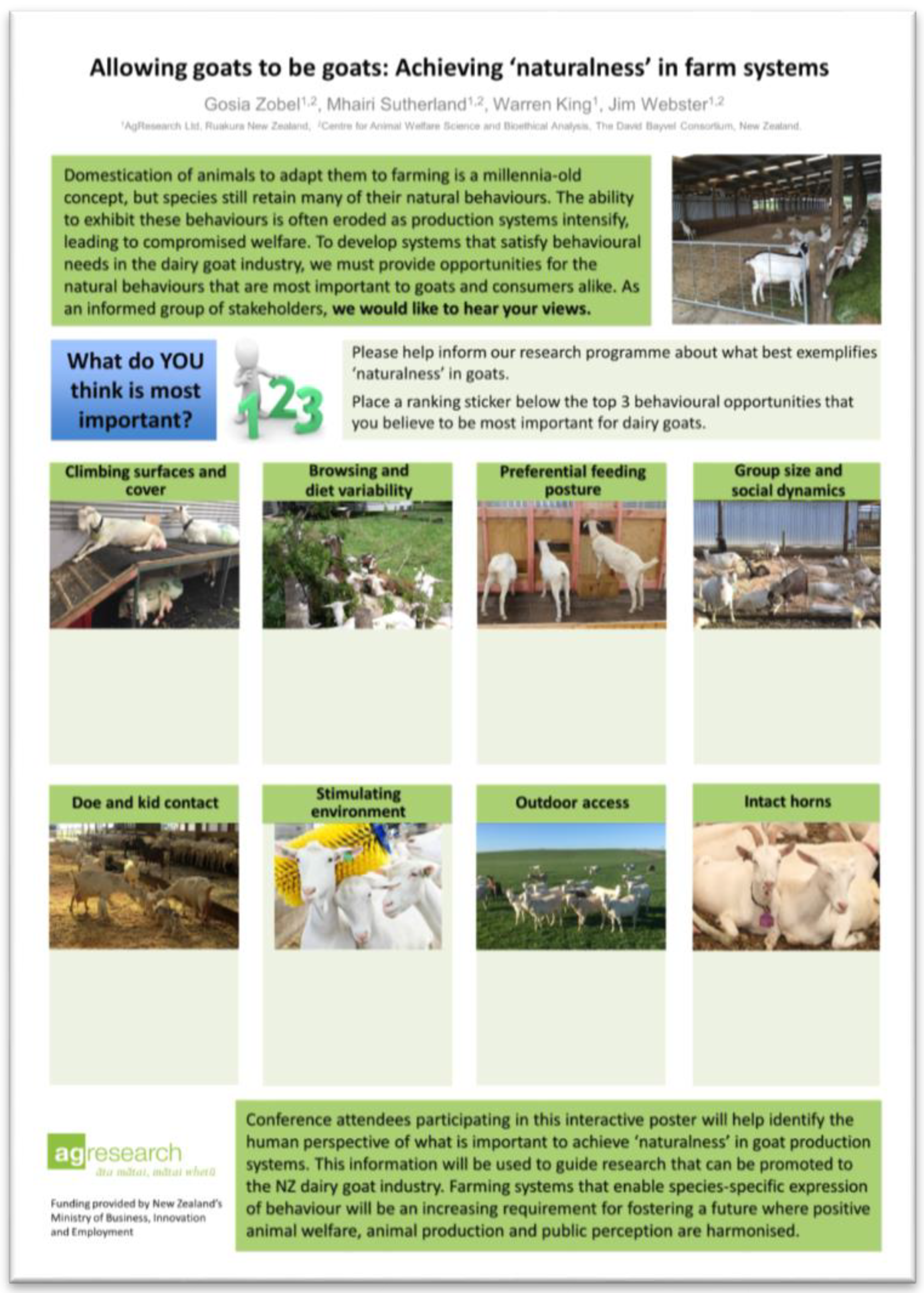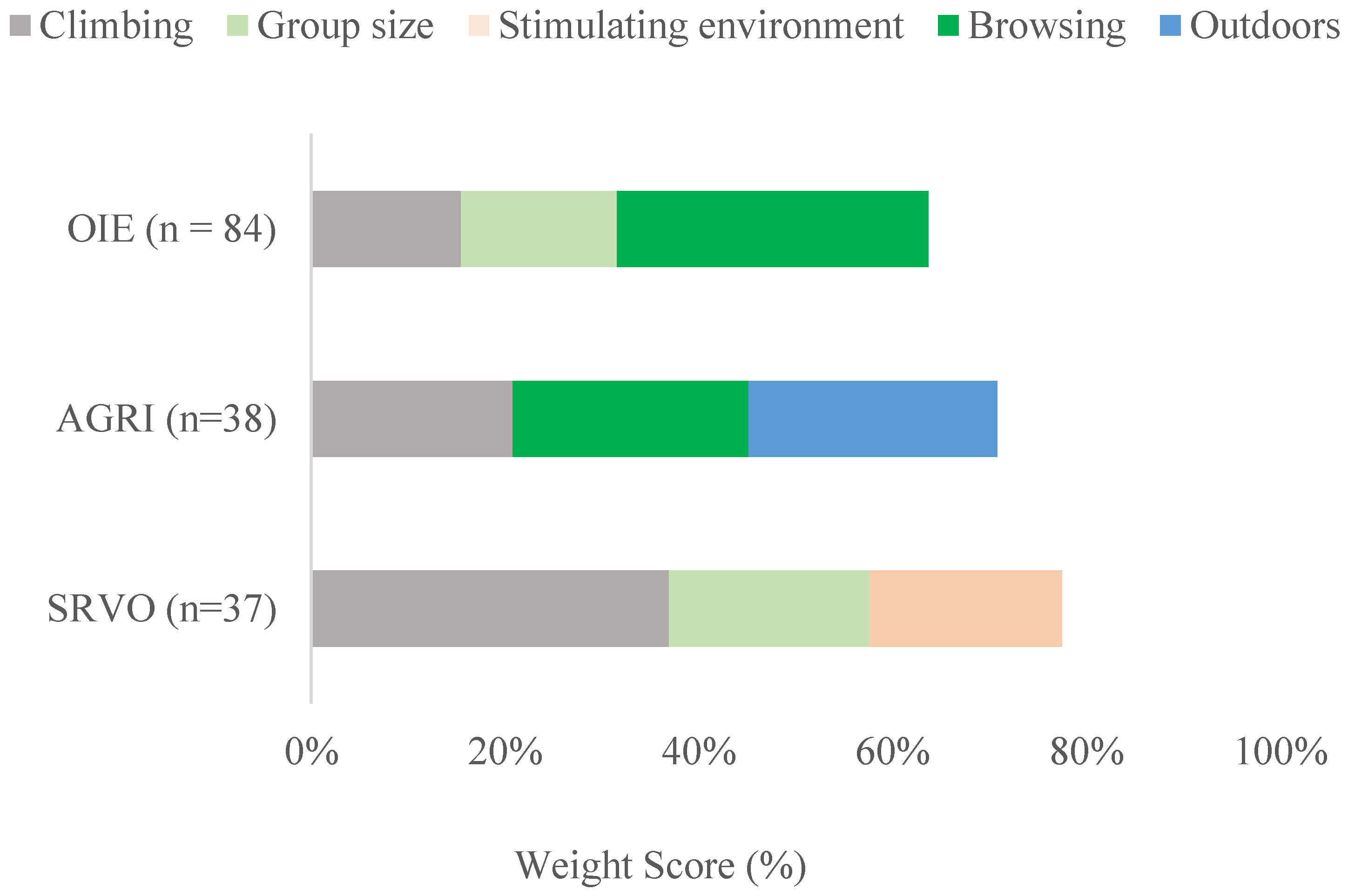Interactive Data-Gathering Posters as a Research Tool: A Case Study Assessing Public Opinion on Incorporation of Natural Behavior into Management Systems
Simple Summary
Abstract
1. Introduction
2. Materials and Methods
2.1. Poster Design and Content
2.2. Poster Presentation and Participants
2.3. Data Handling
3. Results
3.1. Poster Respondents and Use
3.2. Natural Behaviour Importance Ranking
4. Discussion
4.1. The Interactive Poster Format
4.2. Stakeholder Views of Contributors to Goat Welfare
5. Conclusions
Author Contributions
Funding
Acknowledgments
Conflicts of Interest
References
- MacIntosh-Murray, A. Poster Presentations as a Genre in Knowledge Communication: A Case Study of Forms, Norms, and Values. Sci. Commun. 2007, 28, 347–376. [Google Scholar] [CrossRef]
- Lusk, J.L.; Norwood, F.B. A survey to determine public opinion about the ethics and governance of farm animal welfare. J. Am. Vet. Med. Assoc. 2008, 233, 1121–1126. [Google Scholar] [CrossRef] [PubMed]
- Williams, V.M.; Dacre, I.T.; Elliott, M. Public attitudes in New Zealand towards the use of animals for research, testing and teaching purposes. N. Z. Vet. J. 2007, 55, 61–68. [Google Scholar] [CrossRef] [PubMed]
- Thompson, P.B. Animal Ethics and Public Expectations: The North American Outlook. J. Vet. Med. Educ. 2010, 37, 13–21. [Google Scholar] [CrossRef] [PubMed]
- Rowe, N. Academic & Scientific Poster Presentation; Springer International Publishing: Cham, Switzerland, 2017; ISBN 978-3-319-61278-2. [Google Scholar]
- Fraser, D. Understanding animal welfare. Acta Vet. Scand. 2008, 50, S1. [Google Scholar] [CrossRef] [PubMed]
- Fraser, D.; Weary, D.M.; Pajor, E.A.; Milligan, B.N. A Scientific Conception of Animal Welfare that Reflects Ethical Concerns. Anim. Welf. 1997, 6, 187–205. [Google Scholar]
- Brambell, F.W.R. Report of the Technical Committee to Enquire into the Welfare of Animals kept under Intensive Livestock Husbandry Systems; Her Majesty’s Stationery Office: London, UK, 1965.
- Mellor, D.; Beausoleil, N. Extending the “Five Domains” model for animal welfare assessment to incorporate positive welfare states. Anim. Welf. 2015, 24, 241–253. [Google Scholar] [CrossRef]
- Zobel, G.; Neave, H.W.; Webster, J. Understanding natural behavior to improve dairy goat (Capra hircus) management systems. Transl. Anim. Sci. 2019, 3, 212–224. [Google Scholar] [CrossRef]
- Vanhonacker, F.; Van Poucke, E.; Tuyttens, F.; Verbeke, W. Citizens’ Views on Farm Animal Welfare and Related Information Provision: Exploratory Insights from Flanders, Belgium. J. Agric. Environ. Ethics 2010, 23, 551–569. [Google Scholar] [CrossRef]
- Frewer, L.J.; Kole, A.; de Kroon, S.M.A.V.; de Lauwere, C. Consumer Attitudes Towards the Development of Animal-Friendly Husbandry Systems. J. Agric. Environ. Ethics 2005, 18, 345–367. [Google Scholar] [CrossRef]
- Catt, H.; Murphy, M. What voice for the people? categorising methods of public consultation. Aust. J. Polit. Sci. 2003, 38, 407–421. [Google Scholar] [CrossRef]
- King, M.R. The Advisory Committee on Assisted Reproductve Technologies: The Role of Public Consultation in Decision-Making. In Genes, Society and the Future; Human Genome Research Project: Dunedin, NZ, USA, 2007; Volume 1, pp. 147–195. ISBN 978-0-473-12660-5. [Google Scholar]
- Burstein, P. The Impact of Public Opinion on Public Policy: A Review and an Agenda. Polit. Res. Q. 2003, 56, 29–40. [Google Scholar] [CrossRef]
- Rowe, N. Tracing the ‘grey literature’ of poster presentations: A mapping review. Health Inf. Libr. J. 2017, 34, 106–124. [Google Scholar] [CrossRef] [PubMed]
- Ilic, D.; Rowe, N. What is the evidence that poster presentations are effective in promoting knowledge transfer? A state of the art review. Health Inf. Libr. J. 2013, 30, 4–12. [Google Scholar] [CrossRef] [PubMed]
- Roth, B.J. An Academic Perspective on Grey Literature. Archaeologies 2010, 6, 337–345. [Google Scholar] [CrossRef]
- Baddeley, M. Herding, social influence and expert opinion. J. Econ. Methodol. 2013, 20, 35–44. [Google Scholar] [CrossRef]
- Hosseini, J.C.; Armacost, R.L. Gathering Sensitive Data in Organizations. Am. Behav. Sci. 1993, 36, 443–471. [Google Scholar] [CrossRef]
- Bell, C.; Buckley, E.G.; Evans, P.; Lloyd-Jones, G. An evaluation of digital, split-site and traditional formats in conference poster sessions. Med. Teach. 2006, 28, 175–179. [Google Scholar] [CrossRef]
- De Simone, R.; Rodrian, J.; Osswald, B.; Sack, F.-U.; De Simone, E.; Hagl, S. Initial experience with a new communication tool: The ‘Digital Interactive Poster Presentation’. Eur. J. Cardiothorac. Surg. 2001, 19, 953–955. [Google Scholar] [CrossRef]
- Mayhew, E. No Longer a Silent Partner: How Mentimeter Can Enhance Teaching and Learning Within Political Science. J. Polit. Sci. Educ. 2019, 15, 546–551. [Google Scholar] [CrossRef]
- Rudolph, J. A brief review of Mentimeter—A student response system. J. Appl. Learn. Teach. 2018, 1, 35–37. [Google Scholar]
- Reflexivity: A Practical Guide for Researchers in Health and Social Sciences; Finlay, L., Gough, B., Eds.; Blackwell Science: Malden, MA, USA, 2003; ISBN 978-0-632-06414-4. [Google Scholar]
- Braun, V.; Clarke, V. Successful Qualitative Research: A Practical Guide for Beginners; SAGE: Los Angeles, CA, USA, 2013; ISBN 978-1-84787-581-5. [Google Scholar]
- Robbins, J.A. Societal Unease with Modern Agricultural Production: The Case of Animal Welfare. Ph.D. Thesis, University of British Columbia, Vancouver, BC, Canada, 2017. [Google Scholar]
- Mellor, D.J. Updating Animal Welfare Thinking: Moving beyond the “Five Freedoms” towards “A Life Worth Living”. Animals 2016, 6, 21. [Google Scholar] [CrossRef] [PubMed]
- Rice, C.M. Well-being and animals. In The Routledge Handbook of Philosophy of Well-being; Fletcher, G., Ed.; Routledge Handbooks in Philosophy; Routledge: London, UK; New York, NY, USA, 2016; pp. 378–388. ISBN 978-0-415-71453-2. [Google Scholar]
- Špinka, M. How important is natural behaviour in animal farming systems? Appl. Anim. Behav. Sci. 2006, 100, 117–128. [Google Scholar] [CrossRef]
- Neave, H.W.; von Keyserlingk, M.A.G.; Weary, D.M.; Zobel, G. Feed intake and behavior of dairy goats when offered an elevated feed bunk. J. Dairy Sci. 2018, 101, 3303–3310. [Google Scholar] [CrossRef] [PubMed]
- Verbeke, W. Stakeholder, citizen and consumer interests in farm animal welfare. Anim. Welf. 2009, 18, 325–333. [Google Scholar]
- Mouffe, C. Citizenship and Political Identity. October 1992, 61, 28–32. [Google Scholar] [CrossRef]
- Birnbacher, D. Ethics and Social Science: Which Kind of Co-operation? Ethical Theory Moral Pract. 1999, 2, 319–336. [Google Scholar] [CrossRef]
- Musschenga, A.W. Empirical Ethics, Context-Sensitivity, and Contextualism. J. Med. Philos. 2005, 30, 467–490. [Google Scholar] [CrossRef]
- Wensley, D.; King, M. Scientific responsibility for the dissemination and interpretation of genetic research: Lessons from the “warrior gene” controversy. J. Med. Ethics 2008, 34, 507–509. [Google Scholar] [CrossRef]
- Gibbons, M. Science’s new social contract with society. Nature 1999, 402, C81–C84. [Google Scholar] [CrossRef]



© 2020 by the authors. Licensee MDPI, Basel, Switzerland. This article is an open access article distributed under the terms and conditions of the Creative Commons Attribution (CC BY) license (http://creativecommons.org/licenses/by/4.0/).
Share and Cite
King, M.; Webster, J.; Cameron, C.; Zobel, G. Interactive Data-Gathering Posters as a Research Tool: A Case Study Assessing Public Opinion on Incorporation of Natural Behavior into Management Systems. Animals 2020, 10, 971. https://doi.org/10.3390/ani10060971
King M, Webster J, Cameron C, Zobel G. Interactive Data-Gathering Posters as a Research Tool: A Case Study Assessing Public Opinion on Incorporation of Natural Behavior into Management Systems. Animals. 2020; 10(6):971. https://doi.org/10.3390/ani10060971
Chicago/Turabian StyleKing, Mike, James Webster, Catherine Cameron, and Gosia Zobel. 2020. "Interactive Data-Gathering Posters as a Research Tool: A Case Study Assessing Public Opinion on Incorporation of Natural Behavior into Management Systems" Animals 10, no. 6: 971. https://doi.org/10.3390/ani10060971
APA StyleKing, M., Webster, J., Cameron, C., & Zobel, G. (2020). Interactive Data-Gathering Posters as a Research Tool: A Case Study Assessing Public Opinion on Incorporation of Natural Behavior into Management Systems. Animals, 10(6), 971. https://doi.org/10.3390/ani10060971




